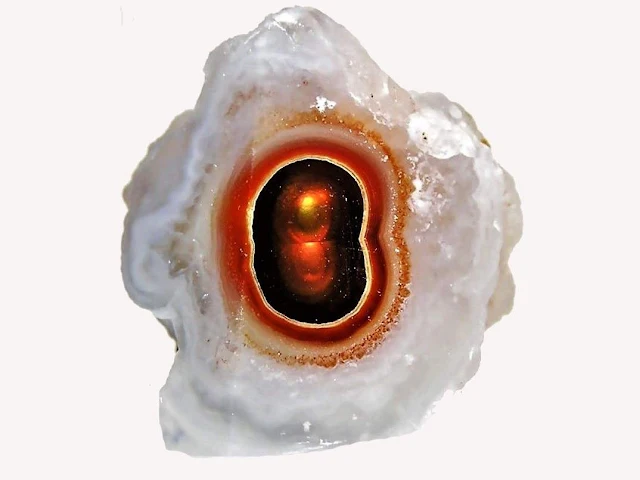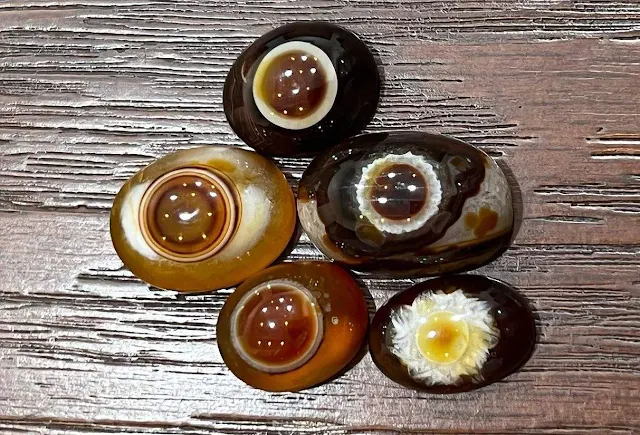What is Eye Agate
Eye Agate is a rare gemstone distinguished by its unique patterns resembling eyes. These "eye-like" formations are created by concentric layers of minerals—such as chalcedony, quartz, and occasionally jasper—that form circular or elliptical bands. The patterns often feature a central "pupil" surrounded by rings mimicking an iris, giving the stone its name.
Eye Agate is not a specific type of agate but rather a descriptive term for any agate exhibiting these concentric or elliptical patterns. The "eyes" form through the gradual accumulation of silica minerals in layered deposits, which, when cut and polished, create the illusion of staring orbs. These formations can vary widely in size and color, ranging from tiny chalcedony specks to large, vibrant rings.
This distinctive pattern can appear in many agate varieties, including Botswana Agate, Crazy Lace Agate, and Ocean Agate, among others.
 |
| Eye agate, pseudomorph agate. Photo: Yagiz Durusoy |
How is Eye Agate formed
Eye agate, with its captivating "eyes," forms through two primary mechanisms:
Geodes and Vugs:
Geodes and Vugs: Silica-rich fluids fill cavities within rocks (geodes and vugs), depositing successive layers of chalcedony on the walls. Variations in composition and environmental conditions during deposition can create concentric banding patterns, sometimes resembling eyes.
Mechanism: Silica-rich fluids fill cavities within rocks, like geodes and vugs. As environmental conditions change (temperature, evaporation), silica precipitates in successive layers on the cavity walls.
Eye Formation: Variations in mineral content, temperature gradients, and crystal nucleation sites can create concentric eye-like patterns with contrasting inner and outer rings.
Agate nodules: As agate nodules form within volcanic rocks, the banding patterns can sometimes develop eye-like formations.
Mechanism: Cavities form within volcanic rocks (gas bubbles, dissolved minerals). Silica-rich fluids fill these cavities, depositing agate layers.
Eye Formation: Pockets of silica gel within the cavity crystallize into spherical or ovoid chalcedony structures, often with distinct core and rim compositions, creating the "eye" patterns.
 |
| Gobi Eyes Agate |
Properties of Eye Agate
Composition: Eye agate is primarily composed of cryptocrystalline silica (SiO₂), specifically chalcedony and quartz. The eye-like patterns are formed by various mineral inclusions like iron oxide, manganese oxide, and other minerals deposited in different colors and textures.
Color: The range of colors in eye agate varies greatly depending on the mineral inclusions. The "pupil" is usually darker, often brown, black, or gray, while the "iris" can be white, gray, red, yellow, orange, blue, green, or a combination of these colors.
Luster: Eye agate has a vitreous luster, meaning it is glassy and shiny.
Hardness: Eye agate typically ranges from 6 to 7 on the Mohs Hardness Scale, making it quite hard and scratch-resistant.
Cleavage: Eye agate generally lacks distinct cleavage, meaning it doesn't break along predictable planes.
Crystal Form: Eye agate doesn't form individual crystals but occurs as nodules, masses, or bands within other rocks.
Transparency: Eye agate can be translucent to opaque, with the transparent areas showcasing the best views of the eye-like patterns.
Fluorescence: Most eye agate doesn't exhibit fluorescence, although some varieties with specific mineral inclusions might show weak fluorescence under longwave ultraviolet light.
Pleochroism: Pleochroism, the variation in color depending on viewing angle, is generally not observed in eye agate due to its cryptocrystalline nature.
 |
| Eye agate, pseudomorph agate. Photo: Yagiz Durusoy |
Uses and Applications of Eye Agate
Jewelry: Eye agate is a popular choice for jewelry, showcasing its eye-like patterns in cabochons, beads, pendants, rings, bracelets, and even earrings. The unique and diverse color combinations make it suitable for various styles and preferences.
Carvings and Sculptures: Skilled artisans utilize eye agate to create intricate carvings and sculptures, highlighting the natural patterns and formations. These artworks range from small figurines and animal sculptures to larger vases, bowls, and decorative objects.
Decorative Objects: The beauty and durability of eye agate make it a perfect material for incorporating into decorative items. It can be found in paperweights, coasters, clocks, lamp bases, and even furniture inlays, adding a touch of natural elegance to any space.
 |
| Fire agate eye |
Metaphysical and Healing Properties:
Some believe eye agate possesses metaphysical properties, such as:
- Promoting inner vision and clarity: The eye-like patterns are associated with enhanced intuition, perception, and spiritual awareness.
- Strengthening psychic abilities: It is believed to aid in clairvoyance, clairaudience, and other psychic gifts.
- Providing protection and grounding: Eye agate is thought to offer protection from negative energy and help ground oneself in the present moment.
- Promoting emotional balance and stability: It is said to soothe anxieties, fears, and emotional turmoil.
Collectors' Item: Eye agate's unique patterns, diverse colors, and rarity make it a sought-after collectible for gemstone enthusiasts and mineral lovers. Collectors appreciate the variety and beauty of individual specimens, often showcasing them in their personal collections.
Caring for Eye Agate
Proper care ensures the enduring beauty of eye agate. Gentle cleaning with mild soap and water, avoiding harsh chemicals and abrasives, is essential. Additionally, protection from direct sunlight and extreme temperatures is crucial to prevent color fading and structural damage.
 |
| Eye Ocean Jasper |
Eye Agate Varieties
The beauty of eye agates lies in their diversity. Some popular varieties include:
Botswana Agate: Renowned for its vibrant orange and red hues, often with well-defined "eyes."
Crazy Lace Agate: Featuring intricate, swirling patterns that resemble lacework.
Ocean Jasper: This type features swirling bands of blues, greens, and whites, reminiscent of the ocean depths. Sometimes, "eyes" can be found within the oceanic patterns.
Fire Agate: This rare and stunning agate displays a fiery iridescence caused by light refracting through thin layers of chalcedony and hematite.
In conclusion, eye agate is more than just a visually stunning gemstone; it is a tangible testament to the Earth's dynamic history and a reflection of our inherent fascination with the unknown. Its intricate patterns, formed through a complex interplay of geological and geochemical processes, continue to captivate scientists and collectors alike.
Read also:
Blue Lace Agate
Iris Agate - A Rainbow in Stone
Moss Agate
Gobi Desert Agate


%20(1).webp)






